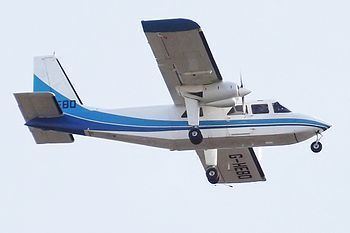Crew 1 Survivors 0 Number of deaths 9 Injuries (nonfatal) 0 | Passengers 8 Fatalities 9 Date 2 August 1984 Location Vieques | |
 | ||
Aircraft type Britten-Norman Islander Destination Saint Croix, U.S. Virgin Islands Similar 1984 TAM – Transport, PBA Flight 1039, Aeroservicios Ecuatorianos Flight 767, 1984 Biman Banglade, Pacific Western Airlines Fl | ||
Vieques Air Link Flight 901A was a flight from Vieques Airport, Vieques, Puerto Rico, to St. Croix, United States Virgin Islands that crashed on August 2, 1984, killing all nine passengers and crew on board.
Contents
Crash
The flight was operated by a Britten-Norman Islander, registration N589SA. After refueling at Vieques Airport, the aircraft took off with one crew member, its pilot, and eight passengers, at 7:55 AM. According to an airport mechanic, the aircraft then lost altitude, the pilot regaining it momentarily before the aircraft banked to its left and nosedived into the Atlantic Ocean.
Investigation
In the course of its investigation the National Transportation Safety Board (NTSB) learned that on March 13, 1984, the young pilot had completed training at a flying school to obtain a commercial pilot's license, but was not qualified to fly as a pilot-in-command of a commuter airliner, being restricted to air charter operations only.
Further investigation revealed that the aircraft's left hand fuel tank had been filled with fuel from an underground tank contaminated with water from previous days of heavy rains, which ultimately caused the No.1 engine to fail. At the time the engine failed, the aircraft was over the ocean. The pilot attempted to turn the aircraft around however, he turned in the wrong direction causing the aircraft to flip and crash into the water.
The aircraft was also overloaded by between 600 lb (272 kg) to 700 lb (318 kg) over its maximum take-off weight.
The aircraft was required to have ten life vests installed. However, the divers who participated in the recovery mission stated that they found no life vests inside the aircraft. The NTSB investigators inspected ten life vests that the airline claimed had been recovered from the wreckage. Four were found to have loose CO₂ gas cylinders, used for inflation of the vests. The Federal Aviation Administration (FAA) later examined all of Vieques Air Link's life vests and found that about 40 percent of them had loose inflation cylinders.
Furthermore, it was also discovered that the aircraft's safety cards depicted a Britten-Norman Trislander, not an Islander; and that the card incorrectly showed the location of the inflation toggle and mouthpiece of the life vest type used by the airline.
Autopsies revealed that the pilot and three passengers died as a result of impact injuries; the five other passengers also had impact injuries but had drowned.
Recommendations
The NTSB issued a list of recommendations in July, 1985, after investigation of this air accident.
